
pltw mi : unit 1 study guide
Author Notes
heyyyy. thank you for visiting this lovely page!! i hope this helps you and me, cuz i made this to help prep for the EOC since my teacher said it’ll be harder than the pbs and hbs ones since they got theirs rewritten..
i think it’ll help to use knowt’s “test me” feature :)
feel free to check out my other unit study guides for mi and beyond 😁😁
﹙✦﹚﹒﹒note that abbreviations are used in the guide!!!!!
﹙Overview﹚
unit 1 explores detecting, fighting, and preventing a infectious disease as it potentially becomes a outbreak in a fictional college!!
╭ Other Resources :
:: unit 1 terms ﹒﹒ a knowt deck of all the unit 1 terms, imported frm my friend’s back at quizlet :)
﹙1.1 Mystery Infection﹚
✦﹒medical intervention is any measure whose purpose is to improve health or alter the course of a disease; below r types of medical interventions + examples
genetics - treatment of genetic disorders ; examples include gene therapy, DNA test
pharmacology - treatment of disease through the application of drugs ; examples include ibuprofen, epi-pen, precision medicine
surgery - a operation that diagnose, evaluates, or treats a medical condition or illness ; examples include biopsy, neurosurgery, cryosurgery
diagnostics - a interventions that helps diagnose a patient’s disease, condition, or injury ; examples include blood test, urine test, imaging tests (mammography, MRI, ultrasound)
immunology - treatment involving the immune system ; examples include chemotherapy, allergy medication, antibiotics
devices - assists with a patient to help monitor/ease symptoms ; examples include glucometer, contacts, eyeglasses, IV monitor, prosthetic limbs
✦﹒in a suspected disease outbreak, it is crucial to identify the pathogen and contact trace the disease
pathogen - a specific causative agent of disease
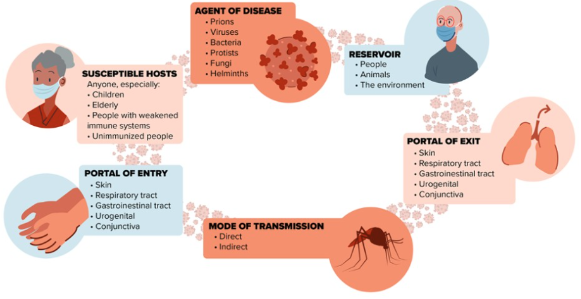 different pathogens that was learnt back in PBS
different pathogens that was learnt back in PBS
contact tracers carry out the work of contact tracing to track the disease exposure, with various skills—
detective work - interviews the infected and ppl who were in contact with them, using the info to understand the transmission
patient education - provides info to ppl abt the disease, leaving instructions on how to protect themselves
social work - listens to concerns and worries, connecting ppl to support resources
✦﹒bioinformatics is the field of science tht combines bio, computers, + info tech to store and analyze data; it can be used to help identify infectious agents involved in disease outbreaks
DNA sequencing is how scientist find the precise order of nucleotides
DNA is isolated frm sample
DNA is processed thru polymerase chain reaction (PCR), making many copies ←these will be primers (short strands of DNA)
DNA segment is denatured + separated ; the template strand is mixed w/primers as the DNA polymerase assembles the nucleotides with free nucleotides becoming fluorescently tagged w/colors
automatic sequencer performs gel electrophoresis to separate the DNA by size ; the fluorescently tagged nucleotides r put in a tube and move towards the positive end and glow as a laser beams shines thru them
red - thymine
green - adenine
blue - cytosine
black - guanine
can’t read - “N”, or none (skipped)
GenBank has a public database containing nucleotide and amino acid sequences of many organisms including diseases
when putting a sequence into the database, focus on the e-value (expect value) and max identity
e-value is accurate and not by chance the closer it is to 0
max identity describes the % of nucleotides frm the sequence tht match w/the query sequence
✦﹒enzyme-linked immunosorbant assay (ELISA) is a in vitro test that tests for the presence of disease antigens or antibodies by color change
antibodies attach themselves to the antigens of the pathogen in order to flag them for destruction by the immune system
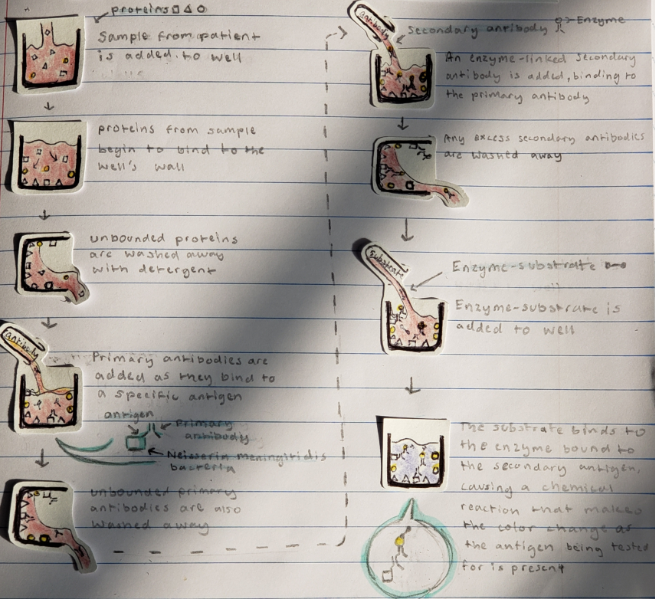 steps of conducting an ELISA test
steps of conducting an ELISA test
a serial dilution is a stepwise dilution of a substance in solution
each tube is expressed by 1/X, where x is the total volume (sample + diluent)
for instance, the img below shows that tube 1’s dilution is 1/20 ; to find the final dilution in tube 2, it is simply 1/20 x 1/20 — then for the final dilution for tube 3, it’ll be 1/20 x 1/20 x 1/20 , and then tube 4 is just like tube 3 but w/another x 1/20
this will only apply for if the sample and diluent are the same for each tube
since the tubes are all the same, the tube dilution will be the same ( 1/20 ) ; only the final dilution is different
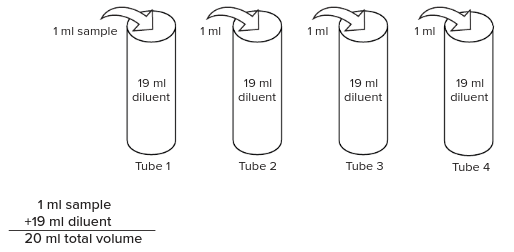
what if the sample amt is not 1?
cross multiply between sample/total volume and 1/X, then solve for x ; plugging in that x value into “1/X” will give you tube dilution
for instance, here’s how to find the tube dilution for tube 1 on problem B (img below)—
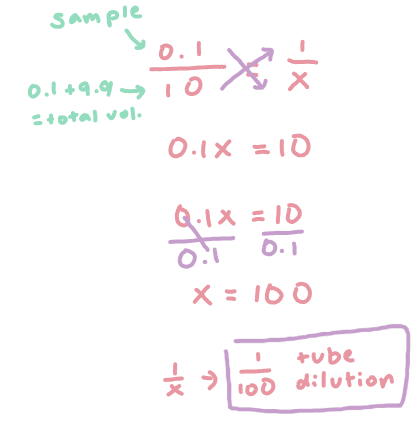
since this we are solving for tube 1, the final dilution will be the same ; solve for the other tubes’ final dilution like normal if the tube sample and diluent + tube dilution are the same for every tube
what if the sample and diluent are both different in each tube?
if this is the case, find the tube dilution like you did for tube 1 (cross multiply, solve for x, plug in 1/X), then multiply the tube dilution by the previous tube dilutions
for instance, if i were to find the final dilation for tube 2, I would set it up like this— 1/100 (tube dilation for tube 1) × 1/50 (tube dilation for tube 2) = 1/5000 (final dilution for tube 2)

sometimes, you may be given a final concentration instead
if the final concentration of tube 1 is 69 ng sample/ml, what is the concentration of the other 2 tubes?
to solve for the concentration of tube 2, do the final concentration x tube 1 dilution like this— 69 (1/100) = 0.69
then for tube 3, do 0.69 (final concentration for tube 2) × 1/50 (tube dilution for tube 2) = 0.0138 (final concentration for tube 3)
﹙✦﹚﹒its very important to have a good understanding of calculating serial dilutions, but otherwise also know how to categorize the types of medical interventions, process of dna sequencing (especially the e-value and max identity) and ELISA, and the relationship between antibodies and antigens with pathogens
→ not included : 1.1.6 Final Diagnosis
﹙1.2 Antibiotic Treatment﹚
✦﹒specific antibiotics are effective at preventing the growth of certain strains of bacteria
antibiotics target certain parts of the bacteria— recall the structure of bacteria, but specifically the components that make bacteria powerful
pili - exchanges genetic material w/other bacteria via contact, allows structure to attach to other bacteria
capsule - protects bacteria frm foreign invaders; determines access of certain cell walls to membrane
endospores - allows the cell to survive harsh conditions
plasmid - holds genetic material + coding genetic advantages (ex: antibiotic resistance)
bacteria can be either gram positive of gram negative ; they hv different resistance abilities

gram negative bacteria - thin wall of peptidoglycan w/multiple layers, gram-stained cells is reddish pink as its high lipid content allows alcohol destain to wash purple stain out of cell walls
outside layer → outer membrane; made of a lipid bilayer tht is composed of endotoxins
outer membrane has porins which allow certain molecules to pass thru the membrane
gram positive bacteria - thick wall of peptidoglycan (20x more than neg), gram-stained cells r purple as high peptidoglycan retains the purple color
no porins + outer membrane, has exotoxins
there are different classes of antibiotics
β-lactams - inhibits bacterial cell wall biosynthesis leading to cell lysis + death
tetracyclines - interferes w/protein synthesis/destroys cell membrane
fluoroquinolones - supercoils within cell, causing impaired DNA replication (by lowering concentration) + cell death (by causing lethal concentrations)
sulfa antibiotics (sulfonamids) -interferes w/the ability of the bacteria to grow + multiply
✦﹒antibiotics have different levels of effectiveness
some antibiotics hv a broad spectrum, where it can kill a wide range of bacteria (both pos + neg)
some antibiotics hv a limited/narrow spectrum, where it can only kill a limited species of bacteria
when looking at the effectiveness of the antibiotic on a petri dish..
zone of inhibition - the zone in which bacterial growth has been inhibited by antibiotic in the disc
greater diameter of zone of inhibition = more effective
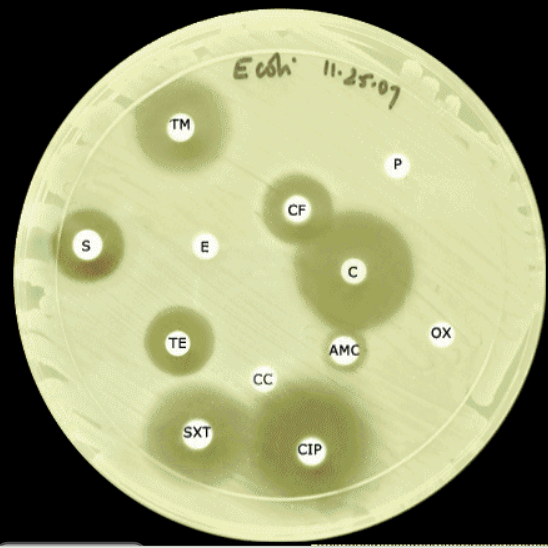 virtual lab ; the C disk is the most effective w/the largest diameter
virtual lab ; the C disk is the most effective w/the largest diameter
✦﹒bacteria gain antibiotic resistance through different ways of collecting the resistant gene
conjugation - where the resistant plasmid is transferred to another bacteria cell by contact with the pilus
transformation - when resistant plasmid left over from a dead cell travels into a nearby bacteria cell, in which it’s DNA becomes incorporated to the bacteria cell’s DNA
transduction - where the bacteria phage infects the bacteria and takes over the genetic processes to reproduce
bacteria hold DNA from the nucleoid (free-floating DNA) or plasmid
✦﹒the misuse of antibiotics can lead to antibiotic resistance of the bacteria
patient is sick ; there are very few bacteria that are resistant to a antibiotic
patient uses antibiotic ; majority of the bacteria are killed off, but a small amount of bacteria containing resistance survive
patient feels better and decides to stop using the antibiotic ; at this time, the resistant bacteria multiplies
patient feels sick and antibiotic no longer helps because the bacteria is resistant now!!!
﹙✦﹚﹒i didn’t go over mechanisms for antibiotic resistance ; mutation, destruction or inactivation, efflux
﹙1.3 The Aftermath: Hearing Loss﹚
✦﹒sound is the mechanical energy tht is transmitted by longitudinal waves in a medium such as water and air, traveling by vibrations and causing movement of particles in the air (sound waves)
pitch is determined by frequency, or how rapidly sound waves vibrate
measured in hertz
high frequency is when the sound wave moves quickly and results in a high pitched sound
low frequency is when the sound wave moves slowly and results in a low pitched sound

volume (also intensity) - determined by the amplitude, or the amount of energy in a wave
high amplitude is when the sound wave is tall and results in loud volume/sound
low amplitude is when the sound wave is short and results in quiet volume/sound
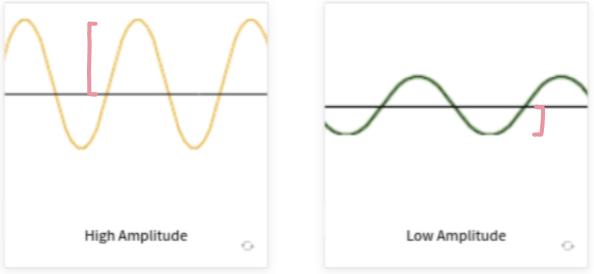
anatomy of the ear
tympanic membrane (ear drum) - causes movement of the three bones in the middle ear, creating vibrations from the sound waves to pass down through the ear
:: ear quiz
these parts of the ear work together to sense and process sound

sound waves enter ear ; causes vibrations in ear drum
vibration of ear drum causes bones in the middle to move back and forth
the inner end of the stapes moves in and out of the oval window at the same rate the eardrum is vibrating
movement against the oval window causes motion in the fluid tht fills the cochlea
fluid movement causes hairs in fluid to move, stimulating the attach cell to send a tiny impulse along the auditory nerve to the brain
brain translates impulse to sound
✦﹒there are different hearing tests that evaluate the hearing of your ear
rinne test - conducted by placing a tuning fork on the mastoid bone (recorded as bone conduction) and then placing it adjacent to the outer ear (recorded as air conduction)
tests for conductive hearing loss
conductive hearing loss is due to problems with the middle ear
results are analyzed by seconds
a person w/o hearing loss should hear air conduction twice as long as bone conduction
a person w/hearing loss is indicated when patient hears more frm the bone conduction than air conduction
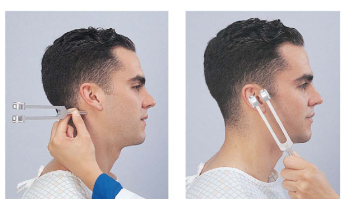 bone conduction→ img on left ; air conduction→ img on right
bone conduction→ img on left ; air conduction→ img on right
speech-in-noise test evaluates the person’s ability to hear speech in a noisy environment ; tests for sensorineural hearing loss
sensorineural hearing loss - hearing loss or impairment resulting frm problems w/the auditory nerves
ppl with this condition sometimes hv trouble understanding speech in a noisy environment
results are recorded on a graph called a audiogram
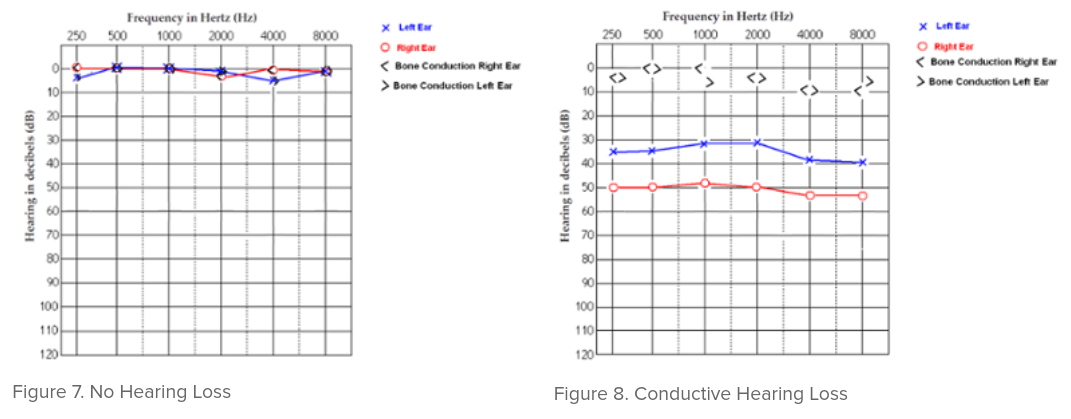
hearing level
dB range
no hearing loss
0-20 dB
mild hearing loss
21-40 dB
moderate hearing loss
41-55 dB
moderate to severe hearing loss
56-70 dB
severe hearing loss
71-90 dB
profound hearing loss
>90 dB
✦﹒a cochlear implant is a electrical prosthetic device helps people with sensorineural hearing loss hear

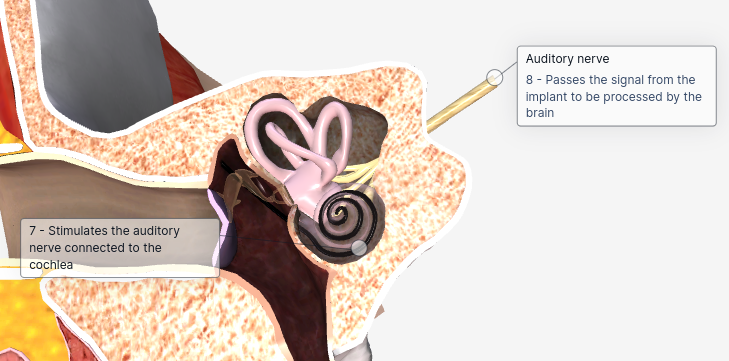 biodigital of how a cochlear implant works ; may want to zoom in to read text
biodigital of how a cochlear implant works ; may want to zoom in to read text
pros —
ability to recognize environmental sound + where it comes frm
ability to understand speech in a noisy environment
ability to hear w/o the need of visual cues
cons —
may hear sounds differently than a normal person does
may lose residual hearing
may obtain issues in balance
﹙✦﹚﹒understand the physics of sound (amplitude + frequency), structure of the ear and how it translates sound, the hearing tests, especially how to interpret a audiogram’s results
﹙1.4 Vaccination﹚
✦﹒there are different types of vaccines
live-attenuated - a type of vaccine that uses a weakened form of the pathogen in order to train the immune system how to fight that pathogen
examples include MMR, smallpox, rotavirus, chicken pox, and yellow fever
inactivated - a type of vaccine uses a killed form of the pathogen in order to train the immune system how to fight that pathogen
weaker than live-attenuated, requires more doses
examples include hepatitus A, flu shot, polio shot, rabies
toxoid - a type of vaccine that uses a toxin made from the pathogen, training the immune system to target the toxin instead of the pathogen itself
needs booster shots for ongoing protection
booster shots make protection more effective as this vaccine type will dec in effectiveness overtime
examples include diphtheria, tetanus
subunit and conjugate - a type of vaccine that uses specific places of the pathogen, training the immune system to target that part of the pathogen instead of the pathogen itself
needs booster shots for ongoing protection
examples include hib, hepatitus B, HPV
✦﹒vaccines are developed to create herd immunity
more immune individuals decrease the occurrence of the disease and pathogen
greater immunized people = less likely for an unimmunized person to encounter the pathogen
recombinant DNA technology uses enzymes + lab techniques to manipulate and isolate DNA segments of interest
the gene of interest is separated frm DNA by restriction enzymes tht cut the DNA and leave sticky ends
restriction enzymes r the “molecular scissors”
MUST have sticky ends in order to combine with plasmid
restriction enzyme cuts a part of the plasmid so the gene of interest can be inserted into the plasmid
DNA ligase works to glue or ligate the gene of interest and plasmid together
plasmid is now recombinant plasmid ; acts as a vector to carry the DNA to the cell
protein of interest is made in cell and multiples as cell undergoes division; used to make vaccines
plasmid may experience self-ligation or inversion, causing the protein of interest to not be produced
self-ligation - plasmid ligates w/o the gene of interest
inversion - gene of interest goes into plasmid backwards
✦﹒epidemiologists monitor the health of populations and search for patterns in disease
attack rate - a percentage found by dividing the number of people at risk who develop a certain illness by the total number of people
epidemic curve - a graphical distribution of times of onset disease
provides key info on how quickly the growth is, what causes it, and if it is ongoing
cohort and case-control study are commonly used by epidemiologists to investigate both infectious and chronic diseases
cohort study - also prospective study, where the investigator inspects a grp of the exposed and nonexposed, following both grps overtime to find incidence of disease
case-control study - also retrospective study, ppl w/disease (called cases) r compared to those that aren’t infected (called control) in which they are carefully matched by age, sex, etc. ; they are surveyed abt exposure to determine the risk factors
﹙✦﹚﹒understand the types of vaccines, herd immunity, ESPECIALLY know the process of recombinant DNA technology and the things that a epidemiologist does
pltw mi : unit 1 study guide
Author Notes
heyyyy. thank you for visiting this lovely page!! i hope this helps you and me, cuz i made this to help prep for the EOC since my teacher said it’ll be harder than the pbs and hbs ones since they got theirs rewritten..
i think it’ll help to use knowt’s “test me” feature :)
feel free to check out my other unit study guides for mi and beyond 😁😁
﹙✦﹚﹒﹒note that abbreviations are used in the guide!!!!!
﹙Overview﹚
unit 1 explores detecting, fighting, and preventing a infectious disease as it potentially becomes a outbreak in a fictional college!!
╭ Other Resources :
:: unit 1 terms ﹒﹒ a knowt deck of all the unit 1 terms, imported frm my friend’s back at quizlet :)
﹙1.1 Mystery Infection﹚
✦﹒medical intervention is any measure whose purpose is to improve health or alter the course of a disease; below r types of medical interventions + examples
genetics - treatment of genetic disorders ; examples include gene therapy, DNA test
pharmacology - treatment of disease through the application of drugs ; examples include ibuprofen, epi-pen, precision medicine
surgery - a operation that diagnose, evaluates, or treats a medical condition or illness ; examples include biopsy, neurosurgery, cryosurgery
diagnostics - a interventions that helps diagnose a patient’s disease, condition, or injury ; examples include blood test, urine test, imaging tests (mammography, MRI, ultrasound)
immunology - treatment involving the immune system ; examples include chemotherapy, allergy medication, antibiotics
devices - assists with a patient to help monitor/ease symptoms ; examples include glucometer, contacts, eyeglasses, IV monitor, prosthetic limbs
✦﹒in a suspected disease outbreak, it is crucial to identify the pathogen and contact trace the disease
pathogen - a specific causative agent of disease
 different pathogens that was learnt back in PBS
different pathogens that was learnt back in PBS
contact tracers carry out the work of contact tracing to track the disease exposure, with various skills—
detective work - interviews the infected and ppl who were in contact with them, using the info to understand the transmission
patient education - provides info to ppl abt the disease, leaving instructions on how to protect themselves
social work - listens to concerns and worries, connecting ppl to support resources
✦﹒bioinformatics is the field of science tht combines bio, computers, + info tech to store and analyze data; it can be used to help identify infectious agents involved in disease outbreaks
DNA sequencing is how scientist find the precise order of nucleotides
DNA is isolated frm sample
DNA is processed thru polymerase chain reaction (PCR), making many copies ←these will be primers (short strands of DNA)
DNA segment is denatured + separated ; the template strand is mixed w/primers as the DNA polymerase assembles the nucleotides with free nucleotides becoming fluorescently tagged w/colors
automatic sequencer performs gel electrophoresis to separate the DNA by size ; the fluorescently tagged nucleotides r put in a tube and move towards the positive end and glow as a laser beams shines thru them
red - thymine
green - adenine
blue - cytosine
black - guanine
can’t read - “N”, or none (skipped)
GenBank has a public database containing nucleotide and amino acid sequences of many organisms including diseases
when putting a sequence into the database, focus on the e-value (expect value) and max identity
e-value is accurate and not by chance the closer it is to 0
max identity describes the % of nucleotides frm the sequence tht match w/the query sequence
✦﹒enzyme-linked immunosorbant assay (ELISA) is a in vitro test that tests for the presence of disease antigens or antibodies by color change
antibodies attach themselves to the antigens of the pathogen in order to flag them for destruction by the immune system
 steps of conducting an ELISA test
steps of conducting an ELISA test
a serial dilution is a stepwise dilution of a substance in solution
each tube is expressed by 1/X, where x is the total volume (sample + diluent)
for instance, the img below shows that tube 1’s dilution is 1/20 ; to find the final dilution in tube 2, it is simply 1/20 x 1/20 — then for the final dilution for tube 3, it’ll be 1/20 x 1/20 x 1/20 , and then tube 4 is just like tube 3 but w/another x 1/20
this will only apply for if the sample and diluent are the same for each tube
since the tubes are all the same, the tube dilution will be the same ( 1/20 ) ; only the final dilution is different

what if the sample amt is not 1?
cross multiply between sample/total volume and 1/X, then solve for x ; plugging in that x value into “1/X” will give you tube dilution
for instance, here’s how to find the tube dilution for tube 1 on problem B (img below)—

since this we are solving for tube 1, the final dilution will be the same ; solve for the other tubes’ final dilution like normal if the tube sample and diluent + tube dilution are the same for every tube
what if the sample and diluent are both different in each tube?
if this is the case, find the tube dilution like you did for tube 1 (cross multiply, solve for x, plug in 1/X), then multiply the tube dilution by the previous tube dilutions
for instance, if i were to find the final dilation for tube 2, I would set it up like this— 1/100 (tube dilation for tube 1) × 1/50 (tube dilation for tube 2) = 1/5000 (final dilution for tube 2)

sometimes, you may be given a final concentration instead
if the final concentration of tube 1 is 69 ng sample/ml, what is the concentration of the other 2 tubes?
to solve for the concentration of tube 2, do the final concentration x tube 1 dilution like this— 69 (1/100) = 0.69
then for tube 3, do 0.69 (final concentration for tube 2) × 1/50 (tube dilution for tube 2) = 0.0138 (final concentration for tube 3)
﹙✦﹚﹒its very important to have a good understanding of calculating serial dilutions, but otherwise also know how to categorize the types of medical interventions, process of dna sequencing (especially the e-value and max identity) and ELISA, and the relationship between antibodies and antigens with pathogens
→ not included : 1.1.6 Final Diagnosis
﹙1.2 Antibiotic Treatment﹚
✦﹒specific antibiotics are effective at preventing the growth of certain strains of bacteria
antibiotics target certain parts of the bacteria— recall the structure of bacteria, but specifically the components that make bacteria powerful
pili - exchanges genetic material w/other bacteria via contact, allows structure to attach to other bacteria
capsule - protects bacteria frm foreign invaders; determines access of certain cell walls to membrane
endospores - allows the cell to survive harsh conditions
plasmid - holds genetic material + coding genetic advantages (ex: antibiotic resistance)
bacteria can be either gram positive of gram negative ; they hv different resistance abilities

gram negative bacteria - thin wall of peptidoglycan w/multiple layers, gram-stained cells is reddish pink as its high lipid content allows alcohol destain to wash purple stain out of cell walls
outside layer → outer membrane; made of a lipid bilayer tht is composed of endotoxins
outer membrane has porins which allow certain molecules to pass thru the membrane
gram positive bacteria - thick wall of peptidoglycan (20x more than neg), gram-stained cells r purple as high peptidoglycan retains the purple color
no porins + outer membrane, has exotoxins
there are different classes of antibiotics
β-lactams - inhibits bacterial cell wall biosynthesis leading to cell lysis + death
tetracyclines - interferes w/protein synthesis/destroys cell membrane
fluoroquinolones - supercoils within cell, causing impaired DNA replication (by lowering concentration) + cell death (by causing lethal concentrations)
sulfa antibiotics (sulfonamids) -interferes w/the ability of the bacteria to grow + multiply
✦﹒antibiotics have different levels of effectiveness
some antibiotics hv a broad spectrum, where it can kill a wide range of bacteria (both pos + neg)
some antibiotics hv a limited/narrow spectrum, where it can only kill a limited species of bacteria
when looking at the effectiveness of the antibiotic on a petri dish..
zone of inhibition - the zone in which bacterial growth has been inhibited by antibiotic in the disc
greater diameter of zone of inhibition = more effective
 virtual lab ; the C disk is the most effective w/the largest diameter
virtual lab ; the C disk is the most effective w/the largest diameter
✦﹒bacteria gain antibiotic resistance through different ways of collecting the resistant gene
conjugation - where the resistant plasmid is transferred to another bacteria cell by contact with the pilus
transformation - when resistant plasmid left over from a dead cell travels into a nearby bacteria cell, in which it’s DNA becomes incorporated to the bacteria cell’s DNA
transduction - where the bacteria phage infects the bacteria and takes over the genetic processes to reproduce
bacteria hold DNA from the nucleoid (free-floating DNA) or plasmid
✦﹒the misuse of antibiotics can lead to antibiotic resistance of the bacteria
patient is sick ; there are very few bacteria that are resistant to a antibiotic
patient uses antibiotic ; majority of the bacteria are killed off, but a small amount of bacteria containing resistance survive
patient feels better and decides to stop using the antibiotic ; at this time, the resistant bacteria multiplies
patient feels sick and antibiotic no longer helps because the bacteria is resistant now!!!
﹙✦﹚﹒i didn’t go over mechanisms for antibiotic resistance ; mutation, destruction or inactivation, efflux
﹙1.3 The Aftermath: Hearing Loss﹚
✦﹒sound is the mechanical energy tht is transmitted by longitudinal waves in a medium such as water and air, traveling by vibrations and causing movement of particles in the air (sound waves)
pitch is determined by frequency, or how rapidly sound waves vibrate
measured in hertz
high frequency is when the sound wave moves quickly and results in a high pitched sound
low frequency is when the sound wave moves slowly and results in a low pitched sound

volume (also intensity) - determined by the amplitude, or the amount of energy in a wave
high amplitude is when the sound wave is tall and results in loud volume/sound
low amplitude is when the sound wave is short and results in quiet volume/sound

anatomy of the ear
tympanic membrane (ear drum) - causes movement of the three bones in the middle ear, creating vibrations from the sound waves to pass down through the ear
:: ear quiz
these parts of the ear work together to sense and process sound

sound waves enter ear ; causes vibrations in ear drum
vibration of ear drum causes bones in the middle to move back and forth
the inner end of the stapes moves in and out of the oval window at the same rate the eardrum is vibrating
movement against the oval window causes motion in the fluid tht fills the cochlea
fluid movement causes hairs in fluid to move, stimulating the attach cell to send a tiny impulse along the auditory nerve to the brain
brain translates impulse to sound
✦﹒there are different hearing tests that evaluate the hearing of your ear
rinne test - conducted by placing a tuning fork on the mastoid bone (recorded as bone conduction) and then placing it adjacent to the outer ear (recorded as air conduction)
tests for conductive hearing loss
conductive hearing loss is due to problems with the middle ear
results are analyzed by seconds
a person w/o hearing loss should hear air conduction twice as long as bone conduction
a person w/hearing loss is indicated when patient hears more frm the bone conduction than air conduction
 bone conduction→ img on left ; air conduction→ img on right
bone conduction→ img on left ; air conduction→ img on right
speech-in-noise test evaluates the person’s ability to hear speech in a noisy environment ; tests for sensorineural hearing loss
sensorineural hearing loss - hearing loss or impairment resulting frm problems w/the auditory nerves
ppl with this condition sometimes hv trouble understanding speech in a noisy environment
results are recorded on a graph called a audiogram

hearing level
dB range
no hearing loss
0-20 dB
mild hearing loss
21-40 dB
moderate hearing loss
41-55 dB
moderate to severe hearing loss
56-70 dB
severe hearing loss
71-90 dB
profound hearing loss
>90 dB
✦﹒a cochlear implant is a electrical prosthetic device helps people with sensorineural hearing loss hear

 biodigital of how a cochlear implant works ; may want to zoom in to read text
biodigital of how a cochlear implant works ; may want to zoom in to read text
pros —
ability to recognize environmental sound + where it comes frm
ability to understand speech in a noisy environment
ability to hear w/o the need of visual cues
cons —
may hear sounds differently than a normal person does
may lose residual hearing
may obtain issues in balance
﹙✦﹚﹒understand the physics of sound (amplitude + frequency), structure of the ear and how it translates sound, the hearing tests, especially how to interpret a audiogram’s results
﹙1.4 Vaccination﹚
✦﹒there are different types of vaccines
live-attenuated - a type of vaccine that uses a weakened form of the pathogen in order to train the immune system how to fight that pathogen
examples include MMR, smallpox, rotavirus, chicken pox, and yellow fever
inactivated - a type of vaccine uses a killed form of the pathogen in order to train the immune system how to fight that pathogen
weaker than live-attenuated, requires more doses
examples include hepatitus A, flu shot, polio shot, rabies
toxoid - a type of vaccine that uses a toxin made from the pathogen, training the immune system to target the toxin instead of the pathogen itself
needs booster shots for ongoing protection
booster shots make protection more effective as this vaccine type will dec in effectiveness overtime
examples include diphtheria, tetanus
subunit and conjugate - a type of vaccine that uses specific places of the pathogen, training the immune system to target that part of the pathogen instead of the pathogen itself
needs booster shots for ongoing protection
examples include hib, hepatitus B, HPV
✦﹒vaccines are developed to create herd immunity
more immune individuals decrease the occurrence of the disease and pathogen
greater immunized people = less likely for an unimmunized person to encounter the pathogen
recombinant DNA technology uses enzymes + lab techniques to manipulate and isolate DNA segments of interest
the gene of interest is separated frm DNA by restriction enzymes tht cut the DNA and leave sticky ends
restriction enzymes r the “molecular scissors”
MUST have sticky ends in order to combine with plasmid
restriction enzyme cuts a part of the plasmid so the gene of interest can be inserted into the plasmid
DNA ligase works to glue or ligate the gene of interest and plasmid together
plasmid is now recombinant plasmid ; acts as a vector to carry the DNA to the cell
protein of interest is made in cell and multiples as cell undergoes division; used to make vaccines
plasmid may experience self-ligation or inversion, causing the protein of interest to not be produced
self-ligation - plasmid ligates w/o the gene of interest
inversion - gene of interest goes into plasmid backwards
✦﹒epidemiologists monitor the health of populations and search for patterns in disease
attack rate - a percentage found by dividing the number of people at risk who develop a certain illness by the total number of people
epidemic curve - a graphical distribution of times of onset disease
provides key info on how quickly the growth is, what causes it, and if it is ongoing
cohort and case-control study are commonly used by epidemiologists to investigate both infectious and chronic diseases
cohort study - also prospective study, where the investigator inspects a grp of the exposed and nonexposed, following both grps overtime to find incidence of disease
case-control study - also retrospective study, ppl w/disease (called cases) r compared to those that aren’t infected (called control) in which they are carefully matched by age, sex, etc. ; they are surveyed abt exposure to determine the risk factors
﹙✦﹚﹒understand the types of vaccines, herd immunity, ESPECIALLY know the process of recombinant DNA technology and the things that a epidemiologist does
 Knowt
Knowt
